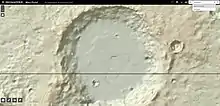Escalante (Martian crater)
Escalante Crater is an impact crater in the Amenthes quadrangle of Mars. It is located at 0.2° N and 244.7° W. It is 79.3 km (49.3 mi) in diameter, and was named after Mexican astronomer (c. 1930) F. Escalante.[1]

 Map of Amenthes quadrangle. The northwest part is the large impact basin Isidis. The crater Escalante sits right on the equator.
Map of Amenthes quadrangle. The northwest part is the large impact basin Isidis. The crater Escalante sits right on the equator.
 CTX camera (on Mars Reconnaissance Orbiter) image of Escalante Crater. Dunes are visible near the bottom of the image.
CTX camera (on Mars Reconnaissance Orbiter) image of Escalante Crater. Dunes are visible near the bottom of the image. Enlargement of dunes in Escalante Crater from previous photo. Image taken with CTX camera (on Mars Reconnaissance Orbiter).
Enlargement of dunes in Escalante Crater from previous photo. Image taken with CTX camera (on Mars Reconnaissance Orbiter).
 Escalante Crater Wall, as seen by HiRISE. Picture on left is enlargement of the one on right. Scale bar is long. | |
| Planet | Mars |
|---|---|
| Coordinates | 0.2°N 244.7°W |
| Quadrangle | Amenthes quadrangle |
| Eponym | Mexican astronomer F. Escalante |
Impact craters generally have a rim with ejecta around them, in contrast volcanic craters usually do not have a rim or ejecta deposits. As craters get larger (greater than 10 km in diameter) they usually have a central peak.[2] The peak is caused by a rebound of the crater floor following the impact.[3] If one measures the diameter of a crater, the original depth can be estimated with various ratios. Because of this relationship, researchers have found that many Martian craters contain a great deal of material; much of it is believed to be ice deposited when the climate was different.[4] Sometimes craters expose layers that were buried. Rocks from deep underground are tossed onto the surface. Hence, craters can show us what lies deep under the surface.
See also
References
- Gazetteer of Planetary Nomenclature Feature Information
- http://www.lpi.usra.edu/publications/slidesets/stones/
- Hugh H. Kieffer (1992). Mars. University of Arizona Press. ISBN 978-0-8165-1257-7. Retrieved 7 March 2011.
- Garvin, J., et al. 2002. Global geometric properities of martian impact craters. Lunar Planet Sci. 33. Abstract @1255.